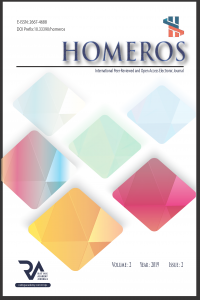YURT AS A MICRO MODEL OF THE UNIVERSE IN THE CONTEXT OF “LANGUAGE: CULTURE” (LINGUISTIC AND CULTURAL ANALYSIS ON THE MATERIAL OF THE KAZAKH AND MONGOLIAN LANGUAGES)
Abstract
One of the
main tasks of Altaistics in the XXI century is to study the interconnection and
relationship between the large language groups, such as Turkic, Mongolian,
Tungus-Manchu and Japanese-Korean, connecting ethnogenesis,
history, traditions and customs, spiritual and cultural heritage and world
outlook of the people speaking these languages, and an interdisciplinary
approach to Altaistics on this basis. It is important to take the
phraseological fund of Altaic languages as the goal of comparative studies,
based on interdisciplinary complexity.
In this
regard, studying mythological-symbolic code of Turkic-Mongolian language
picture of the world by comparing the Kazakh and Mongolian equivalent
phraseologisms, based on kıiz
úı [ki:iz ui] ‘felted
mat house’,
‘yurt’, in the context of “language and culture”, we identify the similarities and
distinctive features of ancient cognition of the Turkic (Kazakh) and Mongolian culture in Central
Asia, historically, culturally and linguistically connected since ancient
times. Kıiz
úı is not just a house,
comfortable for moving from one place to another, but also can
symbolise of
binary oppositions of the universe.
In nomadic worldview kıiz úı – the micro image
of the world, shаńyraq [ʃahyraq] ‘wooden circle forming the smoke opening of a
yurt’ in this image is the micromodel of the Sky, кúldireýish [kuldireuiʃ] 'cross racks on the top side of yurt’ which is connected to shаńyraq like arks symbolises “the
unity of the Space and the Man”, ýyq [uwwq] ‘flexed racks connected to shаńyraq is the symbol of the Sun rays that lights the world.
Keywords
Turkic Kazakh Mongolian language picture of the world traditional culture of nomads mythical-symbolic code nomads’ worldview phraseological system of language language image ethnographic phraseologism internal structure of phraseologisms
References
- AKBERDIEVA B.K. Leksiko-frazeologyalyk juyedegi miftik-tanymdyq qurylymdar. KDA.- Almaty, 2000. B.15.
- AKBERDIEVA B.K. Leksiko-frazeologyalyk juyedegi miftik-tanymdyq qurylymdar. KDA.- Almaty, 2000. B.23.
- AKHMETOV A. Тurki tilderindegi tabu men evfemismder. - Almaty, 1995. B.64.
- AKIM G. Mongol-oros, oros-mongol ovormots heltsiin tol. –UB., 1985. H.62.
- GAADAMBA Sh. Nuuts tovchoony nuutsaas.-UB., 1990. H. 110.
- KENESBAEV I. Qazaq tilining frazeologyalyq sozdigi.- Almaty, 1977.B. 612.
- MASLOVA V.А. Lingvokulturologya. М., 2001. S.87.
- SHAKHANOVA N. Mir traditsionnoi kultury kazakhov.- Almaty, 1998. С. 19-47.
- SMAGULOVA G. Magynalas frazeologismderding ulttyq-madeni aspektileri.- Almaty, 1998. B. 12.
- SMAGULOVA G. Magynalas frazeologismderding ulttyq-madeni aspektileri –Almaty, 1998. Б.168.
- TIMOSHINOV V. Kulturologya: Kazakhstan-Evrasya-Vostok-Zapad. -Almaty, 1997. S.49.
- UALIULY N. Frazeologya jane tildik norma. -Almaty, 1998. B.13.
- WASILEWSKI I. Space in Nomadic Cultures: A Spatial Analysis of the Mongol Yurts// Altaica Collecta.- Wiesbaden, 1976; Ibraev B. Кosmogonicheskie predstavlenya nashih predkov // DI SSSR. 1980. N8. S.40-45.
- ZHUBANOV K. Qazaq tili boiynsha zertteuler. - Almaty, 1999. B.398.
- ZHUKOVSKAYA N.L. Kategorii I simvolika traditsionnoi kultury mongolov.- М., 1988; Sagalayev A.M., Oktyabrskaya I.V., Lvova E.L., Usmanova М.S. Тraditsionnoe mirovozzrenie turkov Yuzhnoi Sibiri: prostranstvo I vremya. Veschny mir. -Novosibirsk, 1988; Toleubaev А.Т. Relikty doislamskih verovanii v semeinoi obryadnosti kazakhov (XIX-ХХcc.). - Almaty, 1991; Galiev А.А. Тraditsionnoe mirovozzrenie kazakhov. - Almaty, 1977; Karakuzova Zh.К., Khasanov М.Sh. Кosmos kazakhskoi kultury.- Almaty, 1993.
Abstract
References
- AKBERDIEVA B.K. Leksiko-frazeologyalyk juyedegi miftik-tanymdyq qurylymdar. KDA.- Almaty, 2000. B.15.
- AKBERDIEVA B.K. Leksiko-frazeologyalyk juyedegi miftik-tanymdyq qurylymdar. KDA.- Almaty, 2000. B.23.
- AKHMETOV A. Тurki tilderindegi tabu men evfemismder. - Almaty, 1995. B.64.
- AKIM G. Mongol-oros, oros-mongol ovormots heltsiin tol. –UB., 1985. H.62.
- GAADAMBA Sh. Nuuts tovchoony nuutsaas.-UB., 1990. H. 110.
- KENESBAEV I. Qazaq tilining frazeologyalyq sozdigi.- Almaty, 1977.B. 612.
- MASLOVA V.А. Lingvokulturologya. М., 2001. S.87.
- SHAKHANOVA N. Mir traditsionnoi kultury kazakhov.- Almaty, 1998. С. 19-47.
- SMAGULOVA G. Magynalas frazeologismderding ulttyq-madeni aspektileri.- Almaty, 1998. B. 12.
- SMAGULOVA G. Magynalas frazeologismderding ulttyq-madeni aspektileri –Almaty, 1998. Б.168.
- TIMOSHINOV V. Kulturologya: Kazakhstan-Evrasya-Vostok-Zapad. -Almaty, 1997. S.49.
- UALIULY N. Frazeologya jane tildik norma. -Almaty, 1998. B.13.
- WASILEWSKI I. Space in Nomadic Cultures: A Spatial Analysis of the Mongol Yurts// Altaica Collecta.- Wiesbaden, 1976; Ibraev B. Кosmogonicheskie predstavlenya nashih predkov // DI SSSR. 1980. N8. S.40-45.
- ZHUBANOV K. Qazaq tili boiynsha zertteuler. - Almaty, 1999. B.398.
- ZHUKOVSKAYA N.L. Kategorii I simvolika traditsionnoi kultury mongolov.- М., 1988; Sagalayev A.M., Oktyabrskaya I.V., Lvova E.L., Usmanova М.S. Тraditsionnoe mirovozzrenie turkov Yuzhnoi Sibiri: prostranstvo I vremya. Veschny mir. -Novosibirsk, 1988; Toleubaev А.Т. Relikty doislamskih verovanii v semeinoi obryadnosti kazakhov (XIX-ХХcc.). - Almaty, 1991; Galiev А.А. Тraditsionnoe mirovozzrenie kazakhov. - Almaty, 1977; Karakuzova Zh.К., Khasanov М.Sh. Кosmos kazakhskoi kultury.- Almaty, 1993.
Details
| Primary Language | English |
|---|---|
| Subjects | Language Studies |
| Journal Section | Research Articles |
| Authors | |
| Publication Date | April 30, 2019 |
| Published in Issue | Year 2019 Volume: 2 Issue: 2 |


